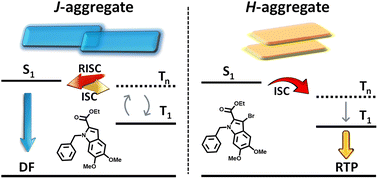Exploring the impact of molecular aggregation on excited-state energy landscapes is key to tailoring long-lived delayed emission in organic materials. Here, we demonstrate aggregation-assisted energy gap modulation governing the balance between delayed fluorescence (DF) and room-temperature phosphorescence (RTP) in the indole-based hybrid charge-transfer emitters – HD and its brominated analogue BrD. In HD, J-aggregation, facilitated by a collinear molecular arrangement, significantly reduces the singlet–triplet energy gap (ΔEST), enhances reverse intersystem crossing (RISC), and increases the efficiency of radiative decay from the regenerated singlet state, thereby favouring DF. In contrast, BrD forms H-aggregates through strong π–π interactions, which increase ΔEST, suppress RISC and stabilize triplet excitons, resulting in prominent RTP. Time-resolved spectroscopy and theoretical calculations reveal that the hybridization of local-excited and charge-transfer states mediates excited-state evolution, with J-aggregation promoting DF and H-aggregation favouring RTP. These results establish a direct link between aggregation and distinct photoluminescence pathways, offering a strategy to tune delayed emission in organic materials.


